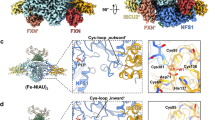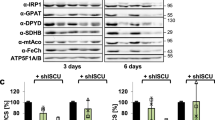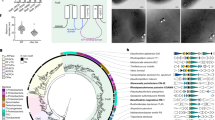Abstract
Iron–sulfur (Fe/S) proteins play crucial roles in living cells by participating in enzyme catalysis, electron transfer and the regulation of gene expression. The biosynthesis of the inorganic Fe/S centers and their insertion into apoproteins require complex cellular machinery located in the mitochondria (Fe/S cluster (ISC) assembly machinery systems) and cytosol (cytosolic Fe/S protein assembly (CIA) systems). Functional defects in Fe/S proteins or their biogenesis components lead to human diseases underscoring the functional importance of these inorganic cofactors for life. In this protocol, we describe currently available methods to follow the activity and de novo biogenesis of Fe/S proteins in eukaryotic cells. The assay systems are useful to follow Fe/S protein maturation in different cellular compartments, identify novel Fe/S proteins and their biogenesis factors, investigate the molecular mechanisms underlying the maturation process in vivo and analyze the effects of genetic mutations in Fe/S protein-related genes. Comprehensive analysis of one biogenesis component or target Fe/S protein takes about 10 d.
This is a preview of subscription content, access via your institution
Access options
Subscribe to this journal
Receive 12 print issues and online access
$259.00 per year
only $21.58 per issue
Buy this article
- Purchase on Springer Link
- Instant access to full article PDF
Prices may be subject to local taxes which are calculated during checkout



Similar content being viewed by others
References
Beinert, H., Holm, R.H. & Münck, E. Iron–sulfur clusters: nature's modular, multipurpose structures. Science 277, 653–659 (1997).
Johnson, D.C., Dean, D.R., Smith, A.D. & Johnson, M.K. Structure, function and formation of biological iron–sulfur clusters. Ann. Rev. Biochem. 74, 247–281 (2005).
Lill, R. & Mühlenhoff, U. Maturation of iron–sulfur proteins in eukaryotes: mechanisms, connected processes, and diseases. Annu. Rev. Biochem. 77, 669–700 (2008).
Ayala-Castro, C., Saini, A. & Outten, F.W. Fe–S cluster assembly pathways in bacteria. Microbiol. Mol. Biol. Rev. 72, 110–125 (2008).
Lill, R. & Mühlenhoff, U. Iron–sulfur protein biogenesis in eukaryotes: components and mechanisms. Annu. Rev. Cell Dev. Biol. 22, 457–486 (2006).
Vickery, L.E. & Cupp-Vickery, J.R. Molecular chaperones HscA/Ssq1 and HscB/Jac1 and their roles in iron–sulfur protein maturation. Crit. Rev. Biochem. Mol. Biol. 42, 95–111 (2007).
Gelling, C., Dawes, I.W., Richhardt, N., Lill, R. & Mühlenhoff, U. Mitochondrial Iba57p is required for Fe/S cluster formation on aconitase and activation of radical SAM enzymes. Mol. Cell Biol. 28, 1851–1861 (2008).
Amutha, B. et al. GTP is required for iron–sulfur cluster biogenesis in mitochondria. J. Biol. Chem. 283, 1362–1371 (2008).
Lill, R. et al. Mechanisms of iron–sulfur protein maturation in mitochondria, cytosol and nucleus of eukaryotes. Biochim. Biophys. Acta 1763, 652–667 (2006).
Kispal, G., Csere, P., Prohl, C. & Lill, R. The mitochondrial proteins Atm1p and Nfs1p are required for biogenesis of cytosolic Fe/S proteins. EMBO J. 18, 3981–3989 (1999).
Balk, J. & Lill, R. The cell's cookbook for iron–sulfur clusters: recipes for fool's gold? Chem. Biol. Chem. 5, 1044–1049 (2004).
Netz, D.J., Pierik, A.J., Stümpfig, M., Mühlenhoff, U. & Lill, R. The Cfd1-Nbp35 complex acts as a scaffold for iron–sulfur protein assembly in the yeast cytosol. Nat. Chem. Biol. 3, 278–286 (2007).
Balk, J., Pierik, A.J., Aguilar Netz, D., Mühlenhoff, U. & Lill, R. The hydrogenase-like Nar1p is essential for maturation of cytosolic and nuclear iron–sulphur proteins. EMBO J. 23, 2105–2115 (2004).
Balk, J., Aguilar Netz, D.J., Tepper, K., Pierik, A.J. & Lill, R. The essential WD40 protein Cia1 is involved in a late step of cytosolic and nuclear iron–sulfur protein assembly. Mol. Cell Biol. 25, 10833–10841 (2005).
Zhang, Y. et al. Dre2, a conserved eukaryotic Fe/S cluster protein, functions in cytosolic Fe/S protein biogenesis. Mol. Cell Biol. 28, 5569–5582 (2008).
Lill, R. & Mühlenhoff, U. Iron–sulfur protein biogenesis in eukaryotes. Trends Biochem. Sci. 30, 133–141 (2005).
Stehling, O., Elsässer, H.P., Brückel, B., Mühlenhoff, U. & Lill, R. Iron–sulfur protein maturation in human cells: evidence for a function of frataxin. Hum. Mol. Genet. 13, 3007–3015 (2004).
Wingert, R.A. et al. Deficiency of glutaredoxin 5 reveals Fe–S clusters are required for vertebrate haem synthesis. Nature 436, 1035–1039 (2005).
Biederbick, A. et al. Role of human mitochondrial Nfs1 in cytosolic iron–sulfur protein biogenesis and iron regulation. Mol. Cell Biol. 26, 5675–5687 (2006).
Pondarré, C. et al. The mitochondrial ATP-binding cassette transporter Abcb7 is essential in mice and participates in cytosolic iron–sulphur cluster biogenesis. Hum. Mol. Genet. 15, 953–964 (2006).
Tong, W.H. & Rouault, T.A. Functions of mitochondrial ISCU and cytosolic ISCU in mammalian iron–sulfur cluster biogenesis and iron homeostasis. Cell Metab. 3, 199–210 (2006).
Song, D. & Lee, F.S. A role for IOP1 in mammalian cytosolic iron–sulfur protein biogenesis. J. Biol. Chem. 283, 9231–9238 (2008).
Stehling, O. et al. Human Nbp35 is essential for both cytosolic iron–sulfur protein assembly and iron homeostasis. Mol. Cell Biol. 28, 5517–5528 (2008).
Rouault, T.A. & Tong, W.H. Iron–sulfur cluster biogenesis and human disease. Trends Genet. 24, 398–407 (2008).
Campuzano, V. et al. Friedreich's ataxia: autosomal recessive disease caused by an intronic GAA triplet repeat expansion. Science 271, 1423–1427 (1996).
Camaschella, C. et al. The human counterpart of zebrafish shiraz shows sideroblastic-like microcytic anemia and iron overload. Blood 110, 1353–1358 (2007).
Mochel, F. et al. Splice mutation in the iron–sulfur cluster scaffold protein ISCU causes myopathy with exercise intolerance. Am. J. Hum. Genet. 82, 652–660 (2008).
Olsson, A., Lind, L., Thornell, L.E. & Holmberg, M. Myopathy with lactic acidosis is linked to chromosome 12q23.3–24.11 and caused by an intron mutation in the ISCU gene resulting in a splicing defect. Hum. Mol. Genet. 17, 1666–1672 (2008).
Kispal, G. et al. Biogenesis of cytosolic ribosomes requires the essential iron–sulphur protein Rli1p and mitochondria. EMBO J. 24, 589–598 (2005).
Klinge, S., Hirst, J., Maman, J.D., Krude, T. & Pellegrini, L. An iron–sulfur domain of the eukaryotic primase is essential for RNA primer synthesis. Nat. Struct. Mol. Biol. 14, 875–877 (2007).
Rudolf, J., Makrantoni, V., Ingledew, W.J., Stark, M.J. & White, M.F. The DNA repair helicases XPD and FancJ have essential iron–sulfur domains. Mol. Cell 23, 801–808 (2006).
Yarunin, A., Panse, V., Petfalski, E., Tollervey, D. & Hurt, E. Functional link between ribosome formation and biogenesis of iron–sulfur proteins. EMBO J. 24, 580–588 (2005).
Sung, P. et al. Human xeroderma pigmentosum group D gene encodes a DNA helicase. Nature 365, 852–855 (1993).
Fan, L. et al. XPD helicase structures and activities: insights into the cancer and aging phenotypes from XPD mutations. Cell 133, 789–800 (2008).
Petillot, Y., Forest, E., Mathieu, I., Meyer, J. & Moulis, J.-M. Analysis, by electrospray ionization mass spectrometry, of several forms of Clostridium pasteurianum rubredoxin. Biochem. J. 296, 657–661 (1993).
Ramelot, T.A. et al. Solution NMR structure of the iron–sulfur cluster assembly protein U (IscU) with zinc bound at the active site. J. Mol. Biol. 344, 567–583 (2004).
Mühlenhoff, U., Gerber, J., Richhardt, N. & Lill, R. Components involved in assembly and dislocation of iron–sulfur clusters on the scaffold protein Isu1p. EMBO J. 22, 4815–4825 (2003).
Molik, S., Lill, R. & Mühlenhoff, U. Methods for studying iron metabolism in yeast mitochondria. Methods Cell Biol. 80, 261–280 (2007).
Stehling, O. et al. Investigation of iron-sulfur protein maturation in eukaryotes. In Methods in Molecular Biology (eds. Leister, D. & Herrmann, J.M.) 325–342 (Humana Press Inc., Totowa, NJ, 2007).
Lutz, T., Westermann, B., Neupert, W. & Herrmann, J.M. The mitochondrial proteins Ssq1 and Jac1 are required for the assembly of iron sulfur clusters in mitochondria. J. Mol. Biol. 307, 815–825 (2001).
Dos Santos, P.C., Johnson, D.C., Ragle, B.E., Unciuleac, M.-C. & Dean, D.R. Controlled expression of nif and isc iron–sulfur protein maturation components reveals target specificity and limited functional replacement between the two systems. J. Bacteriol. 189, 2854–2862 (2007).
Raulfs, E.C., O'Carroll, I.P., Dos Santos, P.C., Unciuleac, M.C. & Dean, D.R. In vivo iron–sulfur cluster formation. Proc. Natl. Acad. Sci. USA 105, 8591–8596 (2008).
Haile, D.J. et al. Cellular regulation of the iron-responsive element binding protein: disassembly of the cubane iron–sulfur cluster results in high-affinity RNA binding. Proc. Natl. Acad. Sci. USA 89, 11735–11739 (1992).
Strain, J. et al. Suppressors of superoxide dismutase (SOD1) deficiency in Saccharomyces cerevisiae. Identification of proteins predicted to mediate iron–sulfur cluster assembly. J. Biol. Chem. 273, 31138–31144 (1998).
Rabinowitz, J.C. Analysis of acid-labile sulfide and sulfhydryl groups. Methods Enzymol. 53, 275–277 (1978).
Thomas, D., Barbey, R., Henry, D. & Surdin-Kerjan, Y. Physiological analysis of mutants of Saccharomyces cerevisiae impaired in sulphate assimilation. J. Gen. Microbiol. 138, 2021–2028 (1992).
De Winde, J.H. & Grivell, L.A. Global regulation of mitochondrial biogenesis in Saccharomyces cerevisiae . Prog. Nucleic Acid Res. Mol. Biol. 46, 51–91 (1993).
Mendel, R.R., Smith, A.G., Marquet, A. & Warren, M.J. Metal and cofactor insertion. Nat. Prod. Rep. 24, 963–971 (2007).
Hirata, A., Klein, B.J. & Murakami, K.S. The X-ray crystal structure of RNA polymerase from Archaea. Nature 451, 851–854 (2008).
Roy, A., Solodovnikova, N., Nicholson, T., Antholine, W. & Walden, W.E. A novel eukaryotic factor for cytosolic Fe–S cluster assembly. EMBO J. 22, 4826–4835 (2003).
Lange, H., Kaut, A., Kispal, G. & Lill, R. A mitochondrial ferredoxin is essential for biogenesis of cellular iron–sulfur proteins. Proc. Natl. Acad. Sci. USA 97, 1050–1055 (2000).
Mühlenhoff, U., Richhardt, N., Gerber, J. & Lill, R. Characterization of iron–sulfur protein assembly in isolated mitochondria: a requirement for ATP, NADH and reduced iron. J. Biol. Chem. 277, 29810–29816 (2002).
Van Ammel, R., Pommé, S. & Sibbens, G. Half-life measurement of 55Fe. Appl. Radiat. Isot. 64, 1412–1416 (2006).
Ghaemmaghami, S. et al. Global analysis of protein expression in yeast. Nature 425, 737–741 (2003).
Hausmann, A. et al. The eukaryotic P-loop NTPase Nbp35: an essential component of the cytosolic and nuclear iron–sulfur protein assembly machinery. Proc. Natl. Acad. Sci. USA 102, 3266–3271 (2005).
Funk, M. et al. Vector systems for heterologous expression of proteins in Saccharomyces cerevisiae . Methods Enzymol. 350, 248–257 (2002).
Lange, H., Kispal, G. & Lill, R. Mechanism of iron transport to the site of heme synthesis inside yeast mitochondria. J. Biol. Chem. 274, 18989–18996 (1999).
Janke, C. et al. A versatile toolbox for PCR-based tagging of yeast genes: new fluorescent proteins, more markers and promoter substitution cassettes. Yeast 21, 947–962 (2004).
Belli, G., Gari, E., Piedrafita, L., Aldea, M. & Herrero, E. An activator/repressor dual system allows tight tetracycline-regulated gene expression in budding yeast. Nucleic Acids Res. 26, 942–947 (1998).
Kanemaki, M., Sanchez-Diaz, A., Gambus, A. & Labib, K. Functional proteomic identification of DNA replication proteins by induced proteolysis in vivo . Nature 423, 720–724 (2003).
Ben-Aroya, S. et al. Toward a comprehensive temperature-sensitive mutant repository of the essential genes of Saccharomyces cerevisiae . Mol. Cell 30, 248–258 (2008).
Schuldiner, M. et al. Exploration of the function and organization of the yeast early secretory pathway through an epistatic miniarray profile. Cell 123, 507–519 (2005).
Siu, F.K., Lee, L.T. & Chow, B.K. Southwestern blotting in investigating transcriptional regulation. Nat. Protoc. 3, 51–58 (2008).
Sherman, F. Getting started with yeast. Methods Enzymol. 350, 3–41 (2002).
Pierik, A.J., Wolbert, R.B.G., Mutsaers, P.H.A., Hagen, W.R. & Veeger, C. Purification and biochemical characterization of a putative [6Fe–6S] prismane-cluster-containing protein from Desulfovibrio vulgaris (Hildenborough). Eur. J. Biochem. 206, 697–704 (1992).
Gietz, R.D. & Woods, R.A. Transformation of yeast by lithium acetate/single-stranded carrier DNA/polyethylene glycol method. Methods Enzymol. 350, 87–96 (2002).
Gibson, J.A. & Marshall, M. The counting efficiency for 55Fe and other E.C. nuclides in liquid scintillator solutions. Int. J. Appl. Radiat. Isot. 23, 321–328 (1972).
Mühlenhoff, U., Richhardt, N., Ristow, M., Kispal, G. & Lill, R. The yeast frataxin homologue Yfh1p plays a specific role in the maturation of cellular Fe/S proteins. Hum. Mol. Genet. 11, 2025–2036 (2002).
Wallace, M.A. et al. Superoxide inhibits 4Fe–4S cluster enzymes involved in amino acid biosynthesis. Cross-compartment protection by CuZn-superoxide dismutase. J. Biol. Chem. 279, 32055–32062 (2004).
Valenzuela, L., Ballario, P., Aranda, C., Filetici, P. & Gonzalez, A. Regulation of expression of GLT1, the gene encoding glutamate synthase in Saccharomyces cerevisiae . J. Bacteriol. 180, 3533–3540 (1998).
Pelzer, W. et al. Mitochondrial Isa2p plays a crucial role in the maturation of cellular iron–sulfur proteins. FEBS Lett. 476, 134–139 (2000).
Barros, M.H., Nobrega, F.G. & Tzagoloff, A. Mitochondrial ferredoxin is required for heme A synthesis in Saccharomyces cerevisiae . J. Biol. Chem. 277, 9997–10002 (2002).
Bradford, M.M. A rapid and sensitive method for the quantification of microgram quantities of protein utilizing the principle of protein dye binding. Anal. Biochem. 72, 248–254 (1976).
Diekert, K., deKroon, A.I.P.M., Kispal, G. & Lill, R. Isolation and sub-fractionation of mitochondria from the yeast Saccharomyces cerevisiae . Methods Cell Biol. 65, 37–51 (2001).
Acknowledgements
We acknowledge generous support from Deutsche Forschungsgemeinschaft (SFB 593 and TR1, Gottfried-Wilhelm Leibniz program, and GRK 1216), the German–Israeli Foundation (GIF), Rhön Klinikum AG, von Behring-Röntgen Stiftung, Max-Planck Gesellschaft, Alexander-von-Humboldt Stiftung and Fonds der chemischen Industrie.
Author information
Authors and Affiliations
Corresponding author
Rights and permissions
About this article
Cite this article
Pierik, A., Netz, D. & Lill, R. Analysis of iron–sulfur protein maturation in eukaryotes. Nat Protoc 4, 753–766 (2009). https://doi.org/10.1038/nprot.2009.39
Published:
Issue Date:
DOI: https://doi.org/10.1038/nprot.2009.39
This article is cited by
-
Monitoring Fe–S cluster occupancy across the E. coli proteome using chemoproteomics
Nature Chemical Biology (2023)
-
Yeast homologs of human MCUR1 regulate mitochondrial proline metabolism
Nature Communications (2020)
-
Iron homeostasis regulates facultative heterochromatin assembly in adaptive genome control
Nature Structural & Molecular Biology (2018)
-
Structure and functional dynamics of the mitochondrial Fe/S cluster synthesis complex
Nature Communications (2017)
-
Silencing of the SlNAP7 gene influences plastid development and lycopene accumulation in tomato
Scientific Reports (2016)
Comments
By submitting a comment you agree to abide by our Terms and Community Guidelines. If you find something abusive or that does not comply with our terms or guidelines please flag it as inappropriate.



